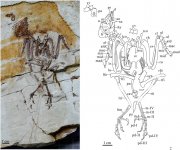albertonykus
Well-known member
Wang, X., A. Cau, X. Luo, M. Kundrát, W. Wu, S. Ju, Z. Guo, Y. Liu, and Q. Ji (2022)
A new bohaiornithid-like bird from the Lower Cretaceous of China fills a gap in enantiornithine disparity
Journal of Paleontology (advance online publication)
doi: 10.1017/jpa.2022.12
A new enantiornithine, Musivavis amabilis n. gen. n. sp., is reported from the Lower Cretaceous Jehol Biota in western Liaoning, China. The new taxon is similar to the bohaiornithids in the robust subconical teeth, bluntly expanded omal ends of the furcula, caudolaterally oriented lateral trabeculae with triangular distal ends of the sternum, and a robust second pedal digit. Yet it differs from members of Bohaiornithidae in several features recalling other enantiornithine lineages, such as the acuminate rostral ramus of maxilla, the shape of the coracoid lateral margin, the presence of craniolateral processes on the sternum, the proportions of the manual phalanges, and the unspecialized third pedal ungual phalanx. A comprehensive phylogenetic analysis of Mesozoic birds shows that homoplasy significantly affects the reconstruction of enantiornithine relationships. When all phylogenetic characters are considered of equal weight, Musivavis is reconstructed in a lineage related to a radiation of large-bodied enantiornithines including Bohaiornithidae and Pengornithidae. Alternative scenarios based on progressive downweighting of the homoplastic characters support more basal placements of the pengornithids among Enantiornithes, but do not alter the affinity of Musivavis as a member of the “bohaiornithid-grade” group.
A new bohaiornithid-like bird from the Lower Cretaceous of China fills a gap in enantiornithine disparity
Journal of Paleontology (advance online publication)
doi: 10.1017/jpa.2022.12
A new enantiornithine, Musivavis amabilis n. gen. n. sp., is reported from the Lower Cretaceous Jehol Biota in western Liaoning, China. The new taxon is similar to the bohaiornithids in the robust subconical teeth, bluntly expanded omal ends of the furcula, caudolaterally oriented lateral trabeculae with triangular distal ends of the sternum, and a robust second pedal digit. Yet it differs from members of Bohaiornithidae in several features recalling other enantiornithine lineages, such as the acuminate rostral ramus of maxilla, the shape of the coracoid lateral margin, the presence of craniolateral processes on the sternum, the proportions of the manual phalanges, and the unspecialized third pedal ungual phalanx. A comprehensive phylogenetic analysis of Mesozoic birds shows that homoplasy significantly affects the reconstruction of enantiornithine relationships. When all phylogenetic characters are considered of equal weight, Musivavis is reconstructed in a lineage related to a radiation of large-bodied enantiornithines including Bohaiornithidae and Pengornithidae. Alternative scenarios based on progressive downweighting of the homoplastic characters support more basal placements of the pengornithids among Enantiornithes, but do not alter the affinity of Musivavis as a member of the “bohaiornithid-grade” group.
Last edited:






